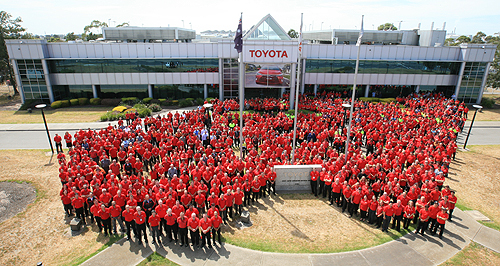News - ToyotaToyota exit: Altona factory ends on a highQuality street: Toyota's Altona factory has recorded its highest levels of quality and productivity in its final years of operation. Altona factory closes at the top of its game as Toyota details employee support4 Oct 2017 IN ITS final few years of operation, Toyota Australia’s Altona factory in Melbourne’s west has achieved the best quality and productivity ratings in its long history, the company’s outgoing president Dave Buttner has revealed. Toyota finally closed the plant yesterday after 54 years of producing cars, ranging from the Tiara which was built between 1963 and 1965 to the final Toyota to be built Down Under – the seventh-generation Camry sedan. Mr Buttner said the factory has met global and Australian standards for production for several years, while Toyota Australia chairman Max Yasuda added that annual audits highlighted the efficiency and dedication of the factory staff. “Every day at the plant you’re judged on safety, productivity, quality and cost, they are the main factors you’re judged on,” Mr Buttner said in an embargoed interview with Australian journalists last week. “There are individual country KPIs (key performance indicators) and global KPIs for every one of those factors and over the last four years the plant has achieved every global KPI that has been established.” Added Mr Yasuda: “We have a quality auditor team in TMC (Toyota Motor Corporation) and they come to Australia once a year to check on our quality. I think our last audit was done beginning of this year, and we achieved the best ever quality levels by this audit. “We have had a better performance than ever before, which itself is a fantastic achievement of our people. Myself, I don’t know how they keep up the motivation, to keep this performance, going through to the end,” he said. At the time of the announcement, in February 2014, Toyota had 3900 employees in Melbourne and Sydney across manufacturing and corporate roles, but that number has subsequently dropped to 1300. The number of staff still working on the final day is difficult to determine. As the final car passes through various stages or processes such as body press, paint, powertrain, final assembly and inspection, those areas are progressively moved offline, therefore the number of people at the very final stage would have been small. Mr Buttner admitted that Toyota had been “fairly insular” in not discussing what the company was doing to prepare for the closure since the 2014 announcement in a bid to protect its staff, and in the interview ahead of the closure he said that Tuesday would be “a pretty heavy day in the history of the company”. Mr Buttner revealed that the in-house event on Tuesday to commemorate 54 years of manufacturing and celebrate the achievements of the workers included a dinner with every staff member and celebrations with “25-year club members, our suppliers, dealer council and our 2500-odd employees ... and of course visiting dignitaries from Toyota in Japan”. Toyota says that approximately 130 Altona employees have been redeployed in other roles, while about 260 have indicated that they now plan to retire. A company spokesperson said it was difficult to gauge the success of Toyota’s reskilling programs until the workforce enters the job market, but that it would become clearer over the next six to 18 months. Toyota launched the first phase of its DRIVE program – which stands for dedicated, ready, individual, vocational and energised – in August 2014 to help employees prepare for their future. A number of DRIVE centres are located around Australia for employees to discuss their future plans with managers and the company says it has recorded engagement of 79 per cent among impacted employees as of July this year. DRIVE centres will remain open for six months after yesterday’s factory closure and more than 2200 people have put their hand up to take part in the program since its inception. The program has provided employees with job skills training, career plans, the opportunity for some company-sponsored training, information on other industries, referrals to financial services and, more recently, has focused on helping people with job-seeking skills such as resume writing and interview techniques.  Read more4th of October 2017  Toyota exit: More than 3.4 million cars made hereAfter 54 years, Toyota closes its factory doors with 3.4 million cars produced4th of October 2017  Toyota exit: Heavy casualties in supply chainJob losses run deep in Toyota supply chain but new doors open for parts-makers4th of October 2017  Toyota exit: Engine plant headed overseasUnnamed Toyota affiliate to get Australian engine plant partly funded by taxpayers4th of October 2017  Toyota exit: TMC boss farewells Aussie plantAkio Toyoda expresses emotional thankyou to 2600 Toyota workers as Altona closes4th of October 2017  Toyota exit: 77 per cent of Sydney staff let goToyota’s sales and marketing transfer to Melbourne causes 280 job casualties4th of October 2017  Toyota exit: Market leader expects to hold sales, shareImpact on sales, brand perception unlikely to shift after factory closure: Toyota16th of June 2017  Toyota Australia records $99 million annual profit$99m profit for Toyota Oz despite restructuring costs, unfavourable exchange rate10th of May 2017  Toyota puts Altona machinery up for saleGiant auto manufacturing equipment sale starts as Toyota shuts up shop in Oz31st of March 2017  Mass exodus of top Toyota execs at year’s endFive top executives with 145 years’ experience between them are set to leave Toyota31st of January 2017  Toyota confirms manufacturing end dateFinal Australian-built Camry to roll off Toyota’s production line on October 310th of January 2017  Detroit show: New Toyota Camry to come from JapanNew beginning for Toyota Camry as sleek replacement to be imported from Japan3rd of August 2016  Toyota commits to late-2017 engine plant closureEngine plant to continue until late 2017 as Toyota Technical Centre closes |
Click to shareToyota articlesResearch Toyota Motor industry news |
















Facebook Twitter Instagram